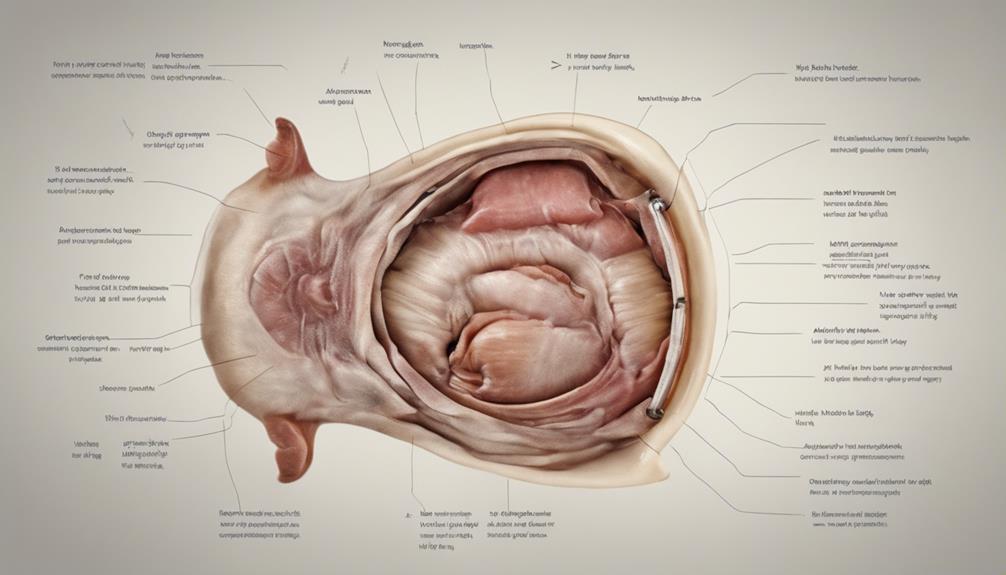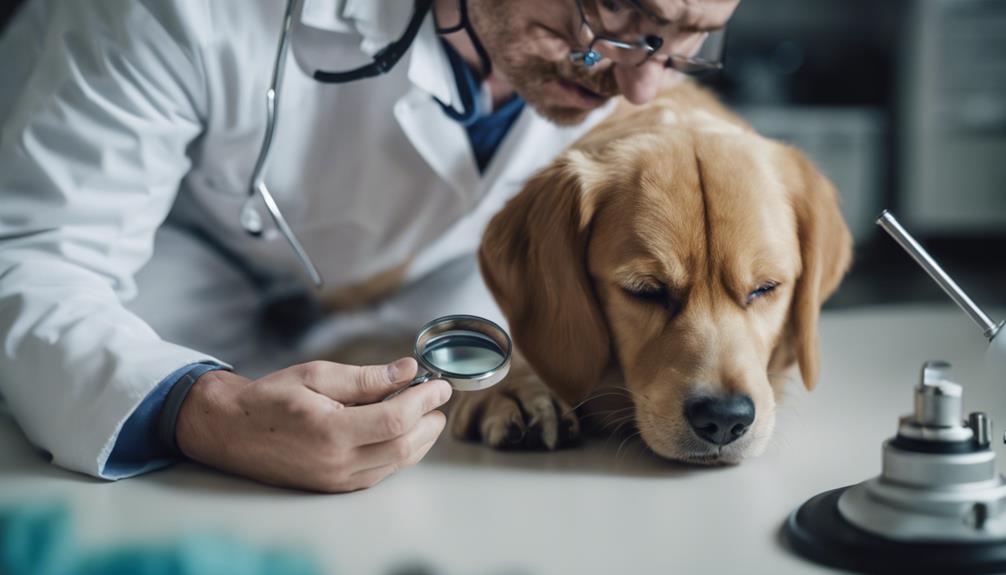In the realm of veterinary anatomy, the peculiar existence of belly buttons in dogs has long intrigued pet owners. The subtle intricacies of these anatomical features, often overlooked, can offer a glimpse into the early stages of a dog's life and development.
While the question of whether dogs possess true belly buttons may seem straightforward, the nuances surrounding their presence and appearance present a fascinating avenue for exploration. Stay tuned to uncover the mysteries surrounding canine belly buttons and gain a deeper understanding of this seemingly ordinary yet intriguing aspect of our canine companions' physiology.
Key Takeaways
- Dogs have belly buttons as scars from the umbilical cord connection after birth.
- Outie belly buttons are not common in dogs; lumps or bumps may signal issues.
- Hernias in dogs can occur if the abdominal wall doesn't close properly.
- Early veterinary care is crucial for any belly button abnormalities in dogs.
Anatomy of Dog Belly Buttons
One defining characteristic of the anatomy of dog belly buttons is the small, flat scar found in the middle of their stomach, serving as a remnant of the umbilical cord connection during gestation. This scar, which is typically a small, flat oval-shaped mark, is located past the rib cage.
In dogs with fur, it may be challenging to spot the belly button visually, but by gently probing the area, a small section of firm skin (scar tissue) can be felt. While dogs do not have true outie belly buttons, thicker tissue in the area may sometimes resemble one.
It is essential to monitor the belly button area for any abnormalities such as lumps, bumps, or changes, as these could indicate underlying issues like hernias, abscesses, or tumors that require prompt veterinary attention.
Umbilical Cord Connection
The belly button area in dogs serves as a significant anatomical reminder of their umbilical cord connection during gestation, specifically highlighting the importance of understanding the process and implications of this umbilical cord attachment. The umbilical cord is vital for supplying essential nutrients and oxygen to the developing puppies while in the womb. It serves as the lifeline between the mother and her offspring, facilitating the exchange of vital substances necessary for growth and development.
After birth, the mother severs this connection, leaving behind a scar that marks the spot where the umbilical cord once attached. This scar, known as the belly button, symbolizes the beginning of a new, independent life for the puppy outside the womb.
Mother's Post-Birth Role

What essential responsibilities does the mother undertake immediately after giving birth to her puppies?
After giving birth, the mother dog plays a crucial role in caring for her puppies. This includes cleaning them to stimulate breathing and circulation, chewing off the umbilical cords, and licking them to keep them warm and encourage urination and defecation. The mother's post-birth care is vital for the survival and well-being of the puppies, as they are born in a vulnerable state and rely entirely on her for nourishment, warmth, and protection.
Additionally, the mother provides comfort and security, creating a bond with her puppies that is essential for their social and emotional development. The mother's nurturing instincts kick in immediately after birth, ensuring the health and safety of her litter.
Location and Appearance
Dogs' belly buttons, situated in the middle of their stomach, serve as visible reminders of their umbilical cord connection during gestation. When examining a dog's belly button, there are a few key things to note:
- Located in the middle of the stomach past the rib cage.
- Typically a small, flat scar that may be oval in shape.
- In dogs with fur, the belly button may be hard to spot.
- By gently probing the area, a small section of firm skin (scar tissue) can be found.
- While not a prominent feature, the belly button is a subtle reminder of a dog's development in the womb.
The Myth of Outie Belly Buttons
In canine anatomy, the presence of true outie belly buttons is a misconception that often leads to misunderstandings about dogs' abdominal structures. While dogs do have belly buttons as scars from the umbilical cord connection, these are typically small, flat scars located in the middle of the stomach.
The idea of dogs having outie belly buttons, protruding significantly from the abdomen, is inaccurate. Thicker tissue in the belly button area may sometimes give the appearance of an outie, but true outies, as seen in humans, are not a normal feature in dogs.
Any unusual lumps or bumps in this area should be monitored closely, as they could indicate underlying issues such as hernias, abscesses, or tumors, requiring prompt veterinary attention for proper diagnosis and treatment.
Signs of Potential Problems
Moving from the discussion on the misconception of outie belly buttons in dogs, it is important to recognize potential signs indicating problems in a dog's belly button area.
- Lumps or Bumps: Any unusual lumps or bumps in the belly button area can indicate a problem.
- Redness or Swelling: Redness or swelling around the belly button could be a sign of an issue.
- Pain or Discomfort: If the dog shows signs of pain or discomfort when the belly button area is touched, it may signal a problem.
- Discharge: Any discharge, especially pus-like discharge, from the belly button area is a cause for concern.
- Changes in Appearance: Any changes in the appearance of the belly button, such as the size or shape, should be monitored closely.
Understanding Hernias in Dogs

Understanding hernias in canines involves grasping the occurrence of organ protrusion through weakened muscle walls, particularly focusing on the potential risks and necessary interventions.
Hernias in dogs can stem from factors such as genetics, trauma, or strain on the abdominal wall. Umbilical hernias, for example, can occur if a puppy's abdominal wall fails to close fully after birth.
Symptoms of hernias in dogs may include a visible bulge, pain, or discomfort. It is crucial to seek veterinary care promptly, as untreated hernias can lead to severe complications, including organ damage and potentially life-threatening situations.
Surgical correction is often necessary to repair the weakened muscle wall and prevent further issues. Monitoring for signs of hernias and addressing them promptly is essential for maintaining a dog's health and well-being.
Dealing With Abscesses
When addressing abscesses in dogs, prompt veterinary attention is essential to ensure proper drainage and antibiotic treatment for these pus-filled collections that can develop in the belly button area.
Abscesses can be serious and require medical intervention to prevent complications. Here are some key points to consider:
- Immediate veterinary care is crucial.
- Abscesses appear as red, swollen lumps.
- Drainage is necessary for treatment.
- Antibiotics are often prescribed to fight infection.
- Bacteria can enter through the umbilical cord remnants.
Importance of Veterinary Care

In ensuring the optimal health and well-being of dogs, timely and thorough veterinary care for any belly button issues is paramount. Early veterinary attention is crucial for detecting and addressing abnormalities in the belly button area.
For conditions like hernias, where an organ protrudes through a weak muscle wall, prompt surgical intervention may be necessary to prevent complications that could endanger the dog's life.
Abscesses, characterized by pus-filled collections, require veterinary drainage and antibiotic treatment to manage infections that can result from skin breaks.
Regular monitoring for lumps, bumps, or any other abnormalities in the belly button area is essential for maintaining a dog's overall health and quality of life.
Conclusion
In conclusion, the presence of belly buttons in dogs is a fascinating aspect of their anatomy that reflects their developmental process.
Understanding the significance of these small scars and being aware of potential abnormalities such as hernias or abscesses is crucial for pet owners.
Prompt veterinary attention and monitoring are essential to ensure the well-being of our canine companions.




